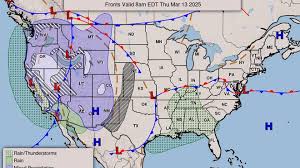A potent March storm has hit California and is on track to cause severe weather across the central and eastern U.S. "The most significant severe weather outbreak of the year" might unfold on Friday and Saturday, potentially affecting over 100 million people. The system poses various risks, from blizzard conditions in the northern Plains to tornadoes and wildfires in the South.
As of Thursday, the storm brought heavy snow and strong winds to the Sierra Nevada and heavy rainfall to parts of coastal southern California. Flash flooding is a concern in some areas of southern California. The National Weather Service has issued warnings due to powerful wind gusts and heavy snow potentially leading to dangerous travel conditions in the Sierra Nevada and northern California.
While the main severe weather outbreak is projected for Friday and Saturday, there is also a potential for severe thunderstorms on Thursday in regions from eastern Mississippi to parts of Alabama, western Georgia, and the Florida Panhandle. The Storm Prediction Center anticipates a regional outbreak of severe storms across the Mississippi Valley and beyond.
Severe thunderstorms are forecasted to move eastward on Friday night, remaining intense past midnight, with expectations of numerous tornadoes and damaging wind gusts by the weekend's end. There's a warning for strong tornadoes potentially striking after dark on Friday, urging people to prepare their storm shelters and emergency supplies in case of tornado warnings.
Apart from severe weather, conditions in the southern high Plains will elevate the risk of critical fire weather, with dry, warm, and windy weather prevailing. Above-average temperatures are foreseen in the central and eastern U.S. The northern Plains are likely to see snow developing from late Friday through Saturday.
Looking ahead, the impending severe Midwest weather paints a concerning picture. Risks for severe thunderstorms, tornadoes, hail, high winds, and potential snow in the Northern Plains and Minnesota are anticipated for the weekend. The National Centers for Environmental Information cites an increase in tornado frequency for March, with predictions of a high number in 2025.
AccuWeather and meteorologists like Tom Kines and David Tolleris highlight the severe weather threats, emphasizing the potential for damage and urging caution. There's a looming threat for tornadoes, large hail, and heavy rainfall that could exacerbate flooding in several states.
Furthermore, a critical situation emerges with drought conditions persisting in numerous Midwest states. Rainfall in March and April is emphasized as crucial for alleviating extreme drought in areas like North Dakota, South Dakota, and Nebraska. The upcoming storm systems are expected to bring much-needed precipitation that may aid these regions.
The focus of the weather narrative shifts to a powerful storm system that is currently wreaking havoc across the country, from coast to coast. The impact includes heavy rain and strong winds in California, heavy snow in the Rockies, blizzard conditions in the Plains, thunderstorms, tornado threats in the Midwest and South, and an increased risk of wildfires in the Southwest and southern Plains.
As the storm progresses, each region faces unique challenges. Flash flood warnings are prevalent in southern California, and evacuation orders are being issued due to the heightened risk of mudslides and debris flow. The Midwest and South brace for widespread damaging winds, tornadoes, and large hail, while the East Coast anticipates heavy rainfall and high winds by the weekend.
The storm's aftermath points to a potential wildfire crisis in the southern Plains due to critical fire weather conditions. A dangerous combination of high winds, low humidity, and dry conditions poses a significant risk for wildfires, prompting officials to issue warnings and urge preparedness among residents to mitigate potential hazards.
Amidst the unfolding weather events, recent extreme occurrences, such as a tornado hitting Orlando, Florida, serve as stark reminders of the unpredictable and destructive nature of these storms. While meteorologists strive to provide early warnings and guidance, the impact of these severe weather events underscores the importance of preparedness and vigilance in safeguarding lives and property.
In conclusion, the convergence of multiple weather phenomena underscores the dynamic and volatile nature of our atmospheric systems. Heightened awareness, preparedness, and timely interventions are essential in mitigating the risks posed by severe weather events, ensuring the safety and resilience of communities nationwide.



